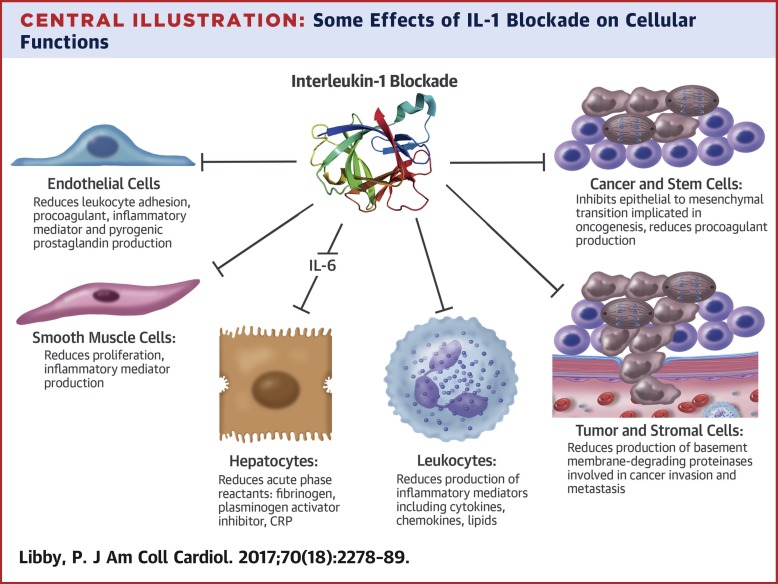当前位置:
X-MOL 学术
›
J. Am. Coll. Cardiol.
›
论文详情
Our official English website, www.x-mol.net, welcomes your
feedback! (Note: you will need to create a separate account there.)
Interleukin-1 Beta as a Target for Atherosclerosis Therapy
Journal of the American College of Cardiology ( IF 21.7 ) Pub Date : 2017-10-01 , DOI: 10.1016/j.jacc.2017.09.028 Peter Libby
Journal of the American College of Cardiology ( IF 21.7 ) Pub Date : 2017-10-01 , DOI: 10.1016/j.jacc.2017.09.028 Peter Libby

|
Inflammatory pathways drive atherogenesis and link conventional risk factors to atherosclerosis and its complications. One inflammatory mediator has come to the fore as a therapeutic target in cardiovascular disease. The experimental and clinical evidence reviewed here support interleukin-1 beta (IL-1β) as both a local vascular and systemic contributor in this regard. Intrinsic vascular wall cells and lesional leukocytes alike can produce this cytokine. Local stimuli in the plaque favor the generation of active IL-1β through the action of a molecular assembly known as the inflammasome. Clinically applicable interventions that interfere with IL-1 action can improve cardiovascular outcomes, ushering in a new era of anti-inflammatory therapies for atherosclerosis. The translational path described here illustrates how advances in basic vascular biology may transform therapy. Biomarker-directed application of anti-inflammatory interventions promises to help us achieve a more precise and personalized allocation of therapy for our cardiovascular patients.
中文翻译:

白细胞介素 1 Beta 作为动脉粥样硬化治疗的靶点
炎症通路驱动动脉粥样硬化,并将常规危险因素与动脉粥样硬化及其并发症联系起来。一种炎症介质已成为心血管疾病的治疗靶点。此处审查的实验和临床证据支持白细胞介素 1 β (IL-1β) 在这方面作为局部血管和全身贡献者。内在血管壁细胞和病变白细胞都可以产生这种细胞因子。斑块中的局部刺激有利于通过称为炎症小体的分子组装的作用产生活性 IL-1β。干扰 IL-1 作用的临床适用干预措施可以改善心血管结局,开创动脉粥样硬化抗炎疗法的新时代。这里描述的转化路径说明了基础血管生物学的进步如何改变治疗。生物标志物导向的抗炎干预应用有望帮助我们为心血管患者实现更精确和个性化的治疗分配。
更新日期:2017-10-01
中文翻译:

白细胞介素 1 Beta 作为动脉粥样硬化治疗的靶点
炎症通路驱动动脉粥样硬化,并将常规危险因素与动脉粥样硬化及其并发症联系起来。一种炎症介质已成为心血管疾病的治疗靶点。此处审查的实验和临床证据支持白细胞介素 1 β (IL-1β) 在这方面作为局部血管和全身贡献者。内在血管壁细胞和病变白细胞都可以产生这种细胞因子。斑块中的局部刺激有利于通过称为炎症小体的分子组装的作用产生活性 IL-1β。干扰 IL-1 作用的临床适用干预措施可以改善心血管结局,开创动脉粥样硬化抗炎疗法的新时代。这里描述的转化路径说明了基础血管生物学的进步如何改变治疗。生物标志物导向的抗炎干预应用有望帮助我们为心血管患者实现更精确和个性化的治疗分配。











































 京公网安备 11010802027423号
京公网安备 11010802027423号